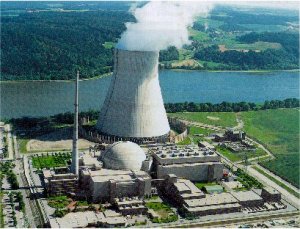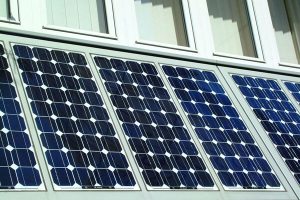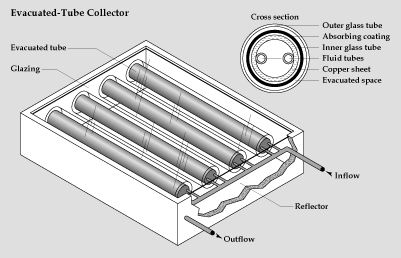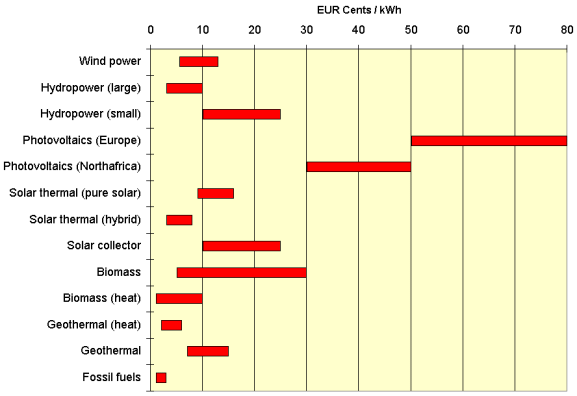|
|
 |
|
|
|
 |
 |
|
|
 |
Context: Energy today and tomorrow
What are the alternatives?
|
Nuclear power
Nuclear power, although relatively cheap, is not an unlimited resource. Resources of uranium will last for about 40 years if there is not any reprocessing. Reprocessing and world-wide expansion of nuclear power means that plutonium, which can also be used in nuclear weapons, has to be traded. This is potentially dangerous in a world of international terrorism and unstable regions.
On top of this, the problem of what to do with long radiating nuclear waste has not yet been solved.
Renewable Energies
|
 |
 |
 |
|
1. Nuclear power plant
© Technical University of Braunschweig
|
|
 |
 |
|
2. Oil seed rape - Can we replace fossil fuels by renewables? © freefoto.com
|
Wind energy
Wind energy can be used more efficiently at sea close to the coast (offshore) than on land (onshore). It is becoming more and more competitive with fossil fuels. However, the locations suitable for the installatoin of wind parks are limited. Therefore, wind energy alone cannot replace fossil fuels. Some people also regard wind power plants as a disfigurement of the landscape.
|
 |
 |
 |
|
3. Wind farm at Palm Springs, California
© freefoto.com, photo: Vincent McMorrow-Purcell
Please click the photo for a larger view! (70 K)
|
|
 |
 |
|
4. Hydro power plant in Britain © Freefoto.com
Please click for a larger view! (80 K)
|
|
 |
Hydro power
Hydro power makes already up 17% of the globally produced electricity (about 2% of the global primary energy demand). This is more than all other renewable resources together. Hydro power can also compete in price. But at most of the places where it can be used without destroying nature and landscape too much, it is already used. Therefore, with increasing energy demand, the relative share of hydro power cannot increase significantly.
|
Solar energy group
Photovoltaics
Photovoltaics transform solar energy by means of semi-conductors. It is probably the technology with the highest potential, but also with the highest development needs and the highest price at the moment. Electricity generation based on photovoltaics costs between 0.5 and 0.75 EUR per kWh compared to less than 0.05 EUR for fossil fuel driven power plants. Moreover the production of solar cells is costly and energy intensive.
|
 |
 |
 |
|
5. Solar cells as part of a house front © Freefoto.com
Please click the photo for a larger view. (100 K)
|
|
|
They have to work for 3-5 years in order to bring in the energy which was needed to produce them. Further improvements are needed in order to make this technology competitive for large scale power generation.
Solar thermal energy
A more competitive technology is solar thermal energy. Here, solar energy is focussed with the help of mirrors or glass tubes onto an absorber, for example water, heating it up . The conversion into electricity can be only efficient in larger power plants (in contrast to photovoltaics).
|
One variant is the solar thermal tower technology, where heat is collected under a massive flat greenhouse and let out through a very high updraft chimney which contains a turbine.
Solutions applicable for the roof are solar collectors. They are used to heat up water and can be for example flat-plate collectors or evacuated tubes.
|
 |
 |
 |
|
8. Solar tube collector © U.S. Department of Energy
|
|
Biomass
Wood, sugar cane, sunflower and rape seed oil and gas from bio-waste are typical biological products used for energy production. After processing they can be used for electricity generation or heating.
|
|
|
 |
Only cheap wood can be used in a competitive way for energy production and resources are limited. Biogas from agronomy, landfills and sewage plants has higher potentials. Rape seed or sunflower oil is in some cases an alternative for fossil oil and can be used as biodiesel. Bio-ethanol from sugar cane or cereals can be blended with fuel for cars or replace it completely in special engines.
Biomass products may be the most competitive renewables which can be introduced on the market rather quickly.
|
|
However, the growing and combustion processes are not free of secondary effects (fertilizers, exhaust gases), which can have negative impacts on ozone layer depletion (N2O emissions), eutrophication (NOx and NH3 emission) and acidification of soils.
At the moment the generation of bio-fuel is a factor of two more expensive than fossil fuel exploitation. This may change with increasing oil and gas prices.
|
Geothermal heat
Temperature increases the deeper you go into the Earth (about 3°C per 100 m in Europe). This heat can be transported to the Earth's surface for example by water as a carrier and heat exchanger.
The problem is that the efficiency depends strongly on the rock formation in the ground. Investment costs for the drilling of boreholes are high and therefore, if the heat source cannot be efficiently exploited, the investor has a high risk of economic losses.
10.On the right: Geothermal heat can be accessed by drilling holes in the Earth and pumping water through as a heat exchanger.
University of California, U.S. Department of Energy
Please click the photo for a larger view
|
 |
|
Electricity-generating costs
A big disadvantage of renewable energies is that they are still significantly more expensive than traditional fossil fuel. The following chart gives an overview of electricity generating costs and in two cases also of heat generating costs for different renewable energies compared to fossil fuels.
|
 |
 |
|
11. Electricity-generating costs for different renewable energies compared to fossil fuels. The fossil fuel costs do not include indirect costs for the compensation of environmental damage.
The content of this website is based on several Internet publications of the International Energy Agency IEA and a brochure "Renewable Energies" (2004) of the German ministry of the environment.
Author: Elmar Uherek, Max Planck Institute for Chemistry Mainz
|
|
 |
|







